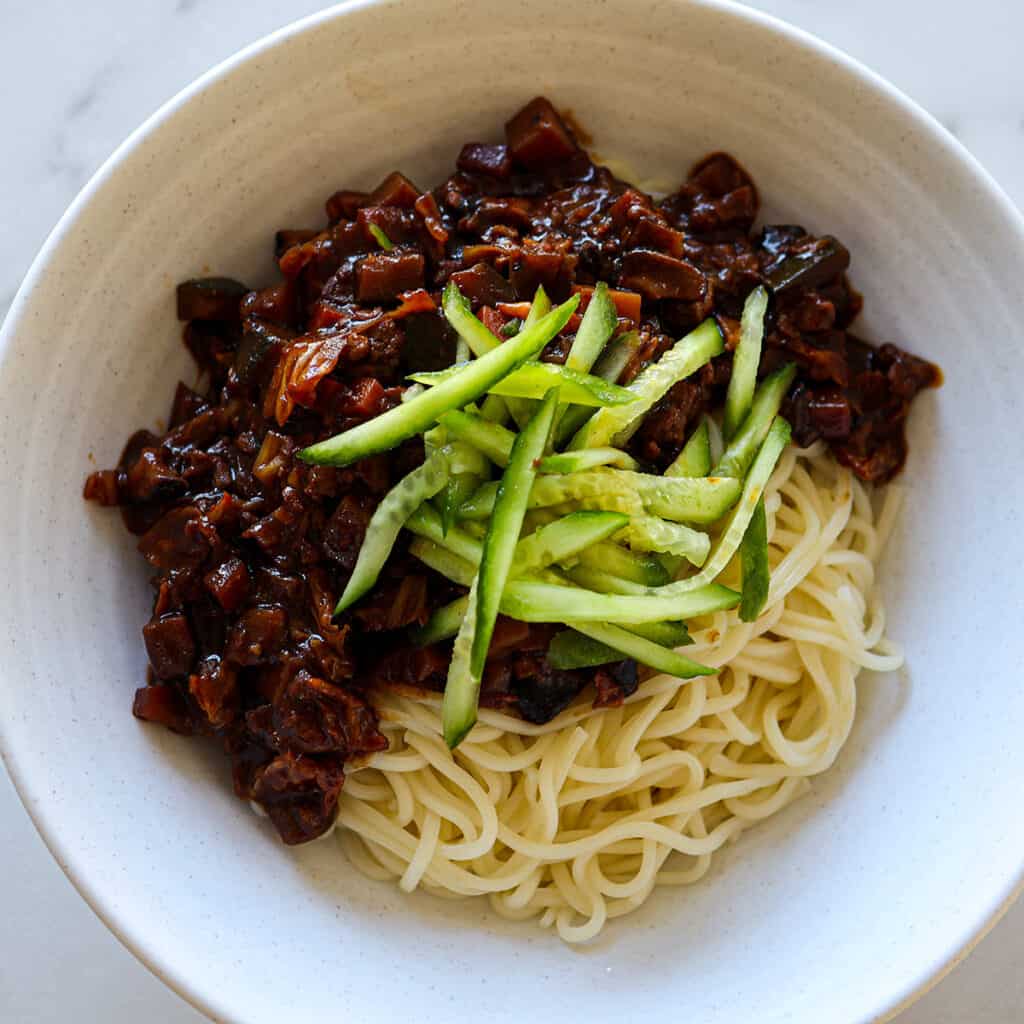
Every Korean kid growing up went to the Chinese Korean restaurant. You always had to order jjajangmyeon (black bean noodles) or jjampong (spicy noodle soup). These are some of Korea’s most beloved dishes even though technically, it’s not Korean cuisine. It is Chinese cuisine that has been adapted to fit the Korean palate. It’s what the Chinese immigrants made in Korea to earn a living in a foreign country. Now jjajangmyeon is one of Korea’s most popular dishes you see in Kdramas and also the most popular delivery food in Korea.
This recipe is a vegan version of this nostalgic and iconic noodle dish. I recipe tested this over and over again, trying to recreate that restaurant flavour. I literally ate jjajangmyeon everyday for lunch and dinner for about 2 weeks perfecting this recipe, and I really think I nailed it. I actually think it tastes better than what you get at the restaurant.
This recipe packs in all the flavours that you want in a bowl of jjajangmyeon without the greasiness (which is sometimes what you get at the restaurant) and guilt (from eating all that msg and animal products that restaurants use). It has a satisfying yet clean flavour, and the flavour balance for this sauce is perfect, not too sweet, not too salty, just the right amount of everything.
I also love that this recipe is loaded with vegetables, making this a much healthier alternative to a dish that is normally not very healthy. I used a variety of most commonly used vegetables for jjajangmyeon. As you might know already, I do not use onions and garlic in any of my cooking because of my meditation practice, but if you feel inclined to use them, please go ahead.
As for the noodles, I highly recommend making or buying fresh noodles, and use noodles that are on the thicker side so that it holds onto the sauce better. My favourite is kalguksu (fresh knife cut noodles). You can find them easily at your local Korean grocery store in the refrigerated section. I always prefer fresh noodles over dried noodles because they tend to be more chewy and taste better too. But if you can’t get fresh noodles, dried udon or dried jjajangmyeon noodles will do the job. I’m sure the store bought refrigerated or frozen udon noodles would work really well too.
Vegan Jjajangmyeon
Ingredients
Frying the black bean paste
- ¼ cup black bean paste aka chunjang (85g)
- ¼ cup neutral oil (55g)
For the sauce
- 2 cups water
- ¼ cup fried black bean paste (85g)
- ½ tablespoon organic cane sugar
- 1 tablespoon cornstarch
- ½ teaspoon mushroom seasoning
- ½ teaspoon black pepper
Vegetables & protein
- ¼ medium carrot (60g) , diced
- ¼ small head green cabbage or savoy cabbage (110g) , diced
- ½ medium zucchini (80g) , diced
- 1 small yukon gold (80g) , diced
- 3 shiitake mushrooms (50g) , stems removed & diced
- 110 g impossible burger or beyond burger or diced extra firm tofu
For stir frying
- 2 tablespoons neutral oil
- 1 teaspoon gochugaru aka Korean red pepper powder (fine or coarse ground)
- 1 teaspoon minced ginger
Noodles
- 2 servings store bought fresh udon/jjajangmyeon or kalguksu (knife-cut noodles) (440g)
Garnish
- Julienned cucumbers
Instructions
Frying the black bean paste
- In a nonstick pan, heat up black bean paste and neutral oil until the oil starts to sizzle. Lower the heat and fry the black bean paste for 3-5 minutes while stirring occasionally. Be careful not to burn the black bean paste. Turn off the heat and set aside. This step gets rid of the bitter and pungent taste of the black bean paste and gives it a nice roasted flavour.
Making the sauce
- In a liquid measuring cup or bowl, whisk together water, sugar, cornstarch, mushroom seasoning, all of the fried black bean paste (without the oil), and black pepper. Set aside.
Stir frying the sauce
- Heat 1 tablespoon of oil in a large nonstick pan on high heat. You can reuse the leftover oil from frying the black bean paste. Add your protein of choice and sauté until lightly golden. If you’re using a ground vegan mock meat, use a spatula to break it down into a crumble. If you’re using tofu, season it to taste with salt and pepper.
- Once the protein is lightly browned, add mushrooms. Sauté mushrooms until golden.
- Lower the heat and move the protein and mushrooms off to one side of the pan, then add 1 tablespoon of oil and minced ginger to the other side. Let the ginger infuse into the oil for about 30 seconds, then add gochugaru and let the gochugaru infuse into the oil for 5-10 seconds. Add carrots, cabbage, potato and zucchini and stir fry everything together for about 2 minutes.
- Stir the sauce mixture thoroughly and pour into the pan. Bring to a boil, then lower the heat to a simmer. Stir the sauce until all the clumps of black bean paste have dissolved. Simmer the sauce for about 20 minutes, stirring occasionally so that it doesn’t burn or stick to the pan. If your sauce looks too dry, you can add an extra ¼ cup of water to loosen it up.
Making the noodles
- While the sauce is simmering, prepare the noodles following the package instructions. Once the noodles are cooked through, rinse the noodles under water to stop them from cooking and to rinse off any starches, then drain off all the excess water.
- Plate the noodles into a bowl and pour the sauce over the noodles. Serve immediately. Garnish with julienned cucumbers if you’d like. Mix the noodles and sauce together with chopsticks and enjoy!

Love this recipe thank you for sharing.
YW! Thank you for commenting! 🙂